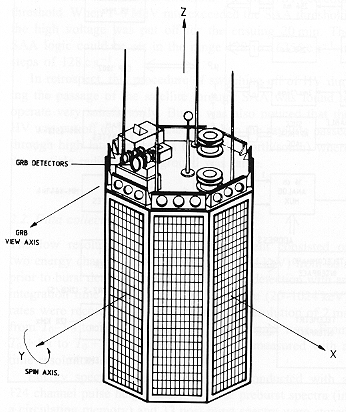|
|
Stretched Rohini Satellite Series (SROSS) 3 & C2

The Indian Space
Research Organization (ISRO)
developed the Stretched ROhini Satellite
Series (SROSS) for conducting various scientific experiments as well
as for new and novel application-oriented missions. The first 2
satellites in the series did not make it into orbit due to launch
vehicle failure. The third, SROSS 3 (also known as SROSS C),
successfully attained an orbit on 20 May 1992. Although they decayed
rapidly, the orbital parameters were initially: apogee ~ 430 km,
perigee ~ 255 km, and orbital inclination ~ 46 degrees. The
satellite spin period was 10.6 s. The satellite carried a gamma-ray
burst (GRB) experiment and a Retarded Potential Analyzer (RPA)
payloads. The spacecraft reentered the Earth's atmosphere on 14 July
1992. SROSS C2, launched on 4 May 1994 with an Indian Augmented Satellite
Launch Vehicle (ASLV-D4), operated at 420 X 620 km orbit
with an inclination of 42 degrees. It reentered the atmosphere in 2001 and is not presently operating.
The GRB experiment operated from 25 May 1992 until reentry on
14 July 1992.
The instrument consisted of a main and a redundant CsI(Na) scintillator
operating in the energy range 20-3000 keV. The crystals were 76 mm (main)
and 37 mm (redundant) in diameter. Each had a thickness of 12.5 mm. A
'burst mode' was triggered by the 100-1024 keV count rate exceeding a
preset limit during a 256 or 1024 ms time integration. In this mode, 65 s
of temporal and 2 s of spectral data prior to the trigger are stored, as
well as the subsequent 16 s of spectral data and 204 s of temporal data.
The low resolution data consists of 2 energy channels (20-100 keV and 100-
1024 keV) from 65 s before the trigger to 204 s after the trigger in 256 ms
integrations. The 20-1024 keV rates are also recorded with a 2 ms
resolution for 1 s prior to 1 s after trigger and a 16 ms resolution for 1s
prior to 8 s after the trigger. Energy spectra are conducted with a 124
channel PHA. Four pre-trigger spectra and 32 post-trigger spectra are
recorded for every burst with a 512 ms integration time.
During the mission lifetime, 53 triggers occurred. Most of these, as
expected, were false. There were 8 candidates for "real" bursts.
One event, on 22 June, was also seen by CGRO and is believed real.
Two other events could be real, as CGRO was not recording data at the
time and so could not corroborate their occurrence.
The GRB experiments on board SROSS-C2 were an improved version of
the GRB payload flown successfully on the SROSS-C satellite.
The improvements regarded enhancements of the on-board memory
and a better measurement of the background spectra after a burst event.
These improvements led to the discovery of twelve candidate events
detected up to 15 February 1995, out of a total of 993 triggers.
The SROSS-C2 spacecraft was one of the satellites included in the
Interplanetary Network ( IPN3).
[Gallery]
[Publications]
[All Missions]
[by Time]
[by Energy]
Page authors: Lorella Angelini Jesse Allen
HEASARC Home |
Observatories |
Archive |
Calibration |
Software |
Tools |
Students/Teachers/Public
Last modified: Thursday, 24-Sep-2020 17:37:05 EDT
|


